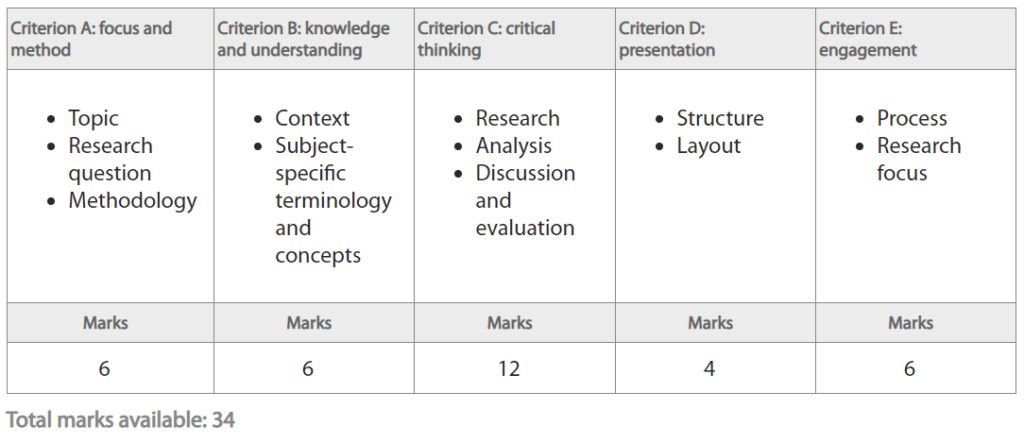OVERVIEW
The marking criteria has 5 specific sections that link well to the structure of the essay:

A breakdown of the key information for each marking criteria is below:
Criterion A
Criterion B
Criterion C
Criterion D
Criterion E
Criterion A
CRITERION A: FOCUS AND METHOD
Criterion A focuses mostly on the basis and basics of your EE, mainly;
ARE YOU INVESTIGATING A GOOD TOPIC (E.G. NOT SIMPLE CHEM)?
- Does your EE topic have a strong grounding in chemistry?
This may sound obvious, but if your EE topic stretches too much into biology (if you look into biochem) or physics (if you look at energy), then it may not have a strong enough grounding in chemistry. Your EE will be marked based on it’s chemistry. If you have 500 words of background research in your essay that focuses on some biological aspect of for example proteins that isn’t really biochemistry, none of it will be marked, it’s not chemistry.
DO YOU HAVE A WELL FOCUSED AND SPECIFIC RESEARCH QUESTION
- How clear is your research question?
By clear, I mean easy to understand, not simple. This part of the criteria will also assess the amount of subject specific terminology in your research question.
IS YOUR METHODOLOGY APPROPRIATE FOR INVESTIGATING YOUR RESEARCH QUESTION?
- Are you using the right methods to answer your research question? Have you used the best method you could? If not, this needs to be discussed somewhere in the report.
JUSTIFICATION OF METHODOLOGY AND EXPERIMENTAL VARIABLES
Both of these sections need to be in your report because they help to answer the above questions, to do with the validity of your experimental method. These sections are discussed more on the ‘Essay Structure’ section.
Criterion B
CRITERION B: KNOWLEDGE AND UNDERSTANDING
This criterion mainly focuses on your background research and the underlying chemistry of your EE. This criterion assesses your understanding and use of chemical theory.;
USE OF CHEMISTRY TERMINOLOGY
- This can quite honestly be achieved by wording your sentences well to include lots of chemistry. Instead of saying ‘the bond is broken’ say ‘the carbon oxygen double bond is broken’, and instead of talking about positives and negatives, talk about anodes and cathodes.
USE OF CHEMICAL EQUATIONS
- This is even more simple. Chemical equations are not included in the word count so whenever it’s not excessive, add a chemical formula. This is chemistry! Make sure you write out the chemical equations for most (not really obvious ones) reactions that occur in your experiment.
SIGNIFICANT FIGURES AND S.I. UNITS
- Again, this is hopefully simple and obvious to incorporate. Don’t work in strange, obscure, non-SI units without good reason and without explaining them in your EE somewhere. If there’s a specific reason that you need to work in gallons or something, state the reason in your EE otherwise the marker will be very confused.
Criterion C
CRITERION C: CRITICAL THINKING
This is the biggest criterion of them all, and should be something you keep in mind throughout writing your EE.
HOW GOOD IS YOUR RESEARCH?
- Have you got a good amount of relevant, chemistry based research? This criterion assesses your critical thinking skills, how did you select your sources? More importantly, how well have you used that research to support your argument/results?
MATHEMATICAL INTERPRETATION OF THE DATA
- How well have you analysed your experimental data? This part is quite difficult, and requires time and effort. It means getting the balance right of which data tables and graphs go in the main body of the essay and the appendix. Be careful though; the appendix is not required reading for the examiner.
PRESENTATION OF GRAPHS AND TABLES
- Critical thinking can also be shown in the way that you present your data. How easy is your data to interpret? Well presented graphs (appropriate axis, line of best fit, error bars etc) help the examiner (and yourself) interpret trends in the data.
Criterion D
CRITERION D: STRUCTURE AND LAYOUT
This is another important part of the essay. I’ve written an entire page on how to structure the chem EE here.
Criterion E